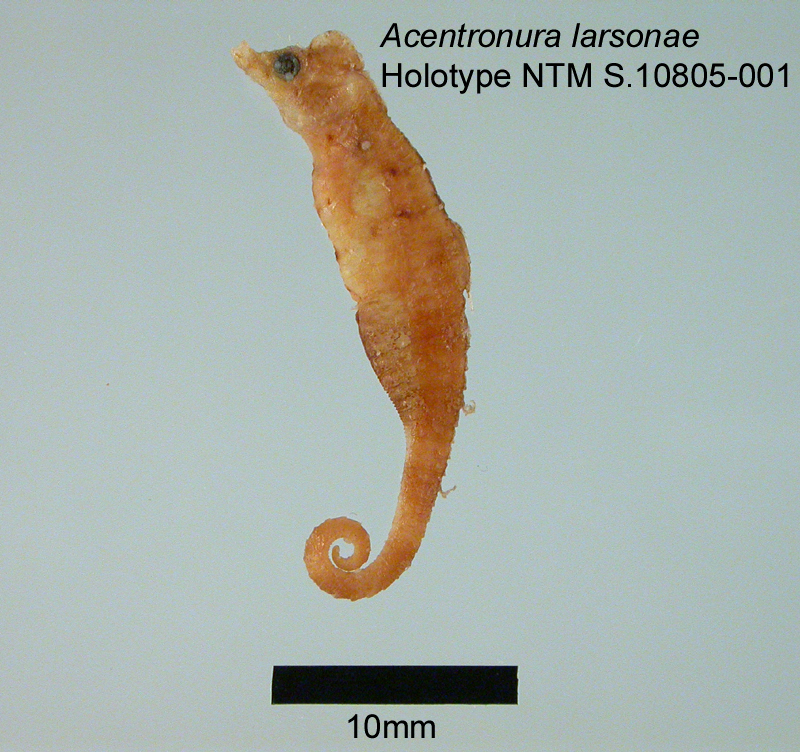Helen's Pygmy Pipehorse, Idiotropiscis larsonae (Dawson 1984)

Holotype of Helen's Pygmy Pipehorse, Idiotropiscis larsonae. Source: Museum and Art Gallery of the Northern Territory. License: CC by Attribution-Noncommercial
This very rare pipehorse is known from only two specimens (a male and a female) found clinging to Sargassum algae at the Monte Bello Islands, Western Australia.
Helen's Pygmy Pipehorse, Idiotropiscis larsonae (Dawson 1984)
More Info
|
Distribution |
Endemic to tropical waters of the Monte Bello Islands, north Western Australia. The species is known only from 2 specimens found clinging to Sargassum sp. attached to isolated coral rock on a sandy coral rubble bottom in a sheltered coral reef in 3 m at Alpha Island, Monte Bello Islands. |
|
Features |
Dorsal fin 17; Anal fin 4; Pectoral fin 12-13; Trunk rings 11; tail rings 39-40. Frontal ridge strongly elevated and protruding clearly anteriorly in adults; superior trunk and tail ridges discontinuous below dorsal fin base; lateral tail ridge present; inferior trunk ridge ends at anal ring; lateral trunk ridge confluent with inferior tail ridge; trunk compressed laterally; dermal flaps relatively long and branched in adults. Single dorsal fin located closer to head than end of tail. |
|
Size |
A very small species - male specimen 34 mm, female specimen 53 mm total length. |
|
Colour |
In preservative: Light tan with brownish markings. Superior ridges of predorsal trunk rings dark brown; side of head and body with irregular pale blotches. Diffuse dark spots on lower part of pectoral fin base and on inferior ridge of 5th and 8th trunk ring. |
|
Feeding |
Unknown - likely to feed on tiny crustaceans. |
|
Biology |
Reproductive mode – ovoviviparous (gives birth to live young) with eggs brooded by males in a sac-like brood pouch under the tail without separate bilateral membranous folds; brood pouch has elongate pouch plates and an anteriror pore-like opening; males are likely to be brooding at 33.5 mm TL. Eggs and larvae have no been described. |
|
Fisheries |
|
|
Conservation |
IUCN Red List Status: Data Deficient Australian Commonwealth legislation: Marine listed under the Environment Protection and Biodiversity Conservation Act 1999 (EPBC Act). |
|
Remarks |
Although Whitley (1947) originally proposed the genus Idiotropiscis due to discontinuous trunk and tail ridges in the type species of Acentronura australe (the type species of the genus Acentronura), Dawson originally described Helen’s Pygmy Pipehorse in the genus Acentronura. |
|
Similar Species |
Idiotropiscis larsonae can be easily distinguished from I. australe by the extremely narrow dorsal region of the predorsal trunk rings, compared with the dorsal region of the post-dorsal tail rings. I. larsonae differs from I. australe in having a more elevated and less anteriorly protruding frontal ridge, having fewer trunk rings and pectoral fin rays (11 and 12-13 versus 12 and 14-15), and a shorter snout. I. larsonae differs from from I. larsonae in its longer trunk with a nearly even depth from just behind the head to the dorsal-fin origin, versus that if I. lumnitzeri which increases greatly in depth anteriorly from just behind the head to the origin of the dorsal fin. |
|
Etymology |
Idiotropiscis is from the Greek idio- (individual, personal) and tropikos (of turning, figurative). The specific name larsonae is in honour of Helen K. Larson (formerly of the Northern Territory Museum and Art Gallery) in recognition of her many contributions to Chuck Dawson’s studies on Indo-Pacific Pipefishes. |
|
Species Citation |
Acentronura (Idiotropiscis) larsonae Dawson 1984, Japan. J. Ichthyol. 31(2): 156, figs. 1-2. Type locality: Alpha Island, Monte Bello Islands, Western Australia. |
|
Author |
Bray, D.J. & Thompson, V.J. 2018 |
|
Resources |
Helen's Pygmy Pipehorse, Idiotropiscis larsonae (Dawson 1984)
References
Allen, G.R. 1997. Marine fishes of tropical Australia and South-east Asia: a field guide for anglers and divers. Western Australian Museum, Perth. 292 pp.
Allen, G.R. & R. Swainston. 1988. The marine fishes of north-western Australia. A field guide for anglers and divers. Western Australian Museum, Perth. 201 pp.
Dawson, C.E. 1984. A new pipehorse (Syngnathidae) from Western Australia, with remarks on the subgenera of Acentronura. Jpn. J. Ichthyol. 31(2): 156–160.
Dawson, C.E. 1985. Indo-Pacific Pipefishes (Red Sea to the Americas). Gulf Coast Research Laboratory, Ocean Springs, Mississippi. 230 pp. [as Acentronura (Idiotropiscis) australe]
Kuiter, R.H. 2004. A new pygmy pipehorse (Pisces: Syngnathidae: Idiotropiscis) from eastern Australia. Rec. Aust. Mus. 56(2): 163–165.
Kuiter, R.H. 2009. Seahorses and their relatives. Aquatic Photographics, Seaford, Australia. Pp. 1–333.
Paulus, T. 1999. Family Syngnathidae. pp 2264-2276, In Capenter K.E. & Niem V.H. (eds) The Living Marine Resources of the Western Central Pacific. FAO Species Identification Guide For Fisheries Purposes. FAO Vol. 4.
Paxton, J.R., J.E. Gates, D.F. Hoese & D.J. Bray. 2006. Syngnathidae (Pp. 810–846). In Beesley, P.L. & Wells, A. (Eds) Zoological Catalogue of Australia. Volume 35. Fishes. ABRS & CSIRO Publishing, Australia., 3 vols.
Pogonoski, J.J., D.A. Pollard & J.R. Paxton. 2002. Conservation Overview and Action Plan for Australian Threatened and Potentially Threatened Marine and Estuarine Fishes, Environment Australia, Canberra. 375 pp.
Pollom, R. 2016. Acentronura larsonae (errata version published in 2017). The IUCN Red List of Threatened Species 2016: e.T65368802A115424465. http://dx.doi.org/10.2305/IUCN.UK.2016-3.RLTS.T65368802A67618644.en. Downloaded on 13 March 2018.
Whitley, G.P. 1947. New Sharks and fishes from Western Austalia, Part 3. Aust. Zool. 11(2): 129–150.


